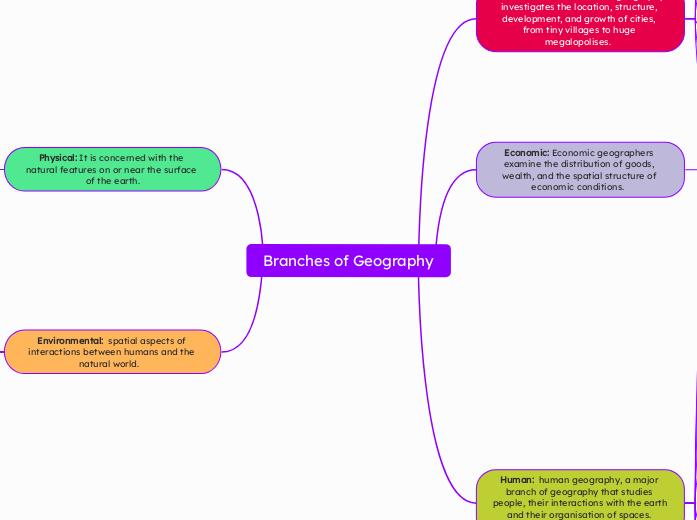Branches of Geography
Urban: The branch of urban geography investigates the location, structure, development, and growth of cities, from tiny villages to huge megalopolises.
Quantitative methods: Quantitative geography uses math and models to test hypotheses. While widely applied in geography, some geographers focus solely on these methods. ➕➖➗✖️
Transportation geography: Transportation geographers study how transportation networks (both public and private) move people and goods. 🚓
Regional Geography: Regional geographers study specific areas, from entire continents to small urban regions, often combining this focus with another branch of geography. 🗺️
Geography Education: Geographers working in the field of geographic education help to give teachers the skills, knowledge, and tools they need. 🍎
Applied Geography: Applied geographers use geographic knowledge, skills, and techniques to solve problems in everyday society. ➕
Economic: Economic geographers examine the distribution of goods, wealth, and the spatial structure of economic conditions.
Water Resource Management: Water resource geographers study how water moves through the hydrologic cycle and how people store, distribute, and use it. 💧
Population Geography: Population Geography focuses on the distribution, movement, and growth of populations in different areas. It’s more than just studying birth and death it looks at how people are spread out and how they move over time. 🧬
Human: human geography, a major branch of geography that studies people, their interactions with the earth and their organisation of spaces.
Geography of Religions: This branch of geography studies the geographic distribution of religious groups and built environments. ✝️
Medical Geography: Medical geographers study the geographic distribution of disease, illness, death and health care. 👩🏻⚕️
Recreation, Tourism, and Sport geography: Recreation, Tourism, and Sport Geography looks at how leisure activities like travel and sports affect places. Geographers study how tourism, a big industry, causes people to move temporarily and impacts the environment. 🥎
Military Geography: Military Geography focuses on the location of military bases and troops, and uses geographic tools to help create military strategies and solutions. 🪖
Political Geography: Political Geography studies boundaries, countries, states, nations, and how they develop. It also looks at things like voting, international organizations, and diplomacy. 🗺️
Geographic Information Systems: Geographic Information Systems (GIS) is a field that creates databases of geographic data and uses technology to display this data in map form. GIS experts combine different layers of information to create detailed maps and solve geographic problems easily. 🗺️
Cartography: Cartographers create maps using geographic knowledge and techniques to visualize data. They work in academia, private firms, and government agencies 🗺️📊.
Agricultural and Rural Geography: Geographers in this branch study rural settlement, the distribution of agriculture and the geographic movement and access to agricultural products, and land use in rural areas. 🚜
Hazard Geography: Hazard geography adds together physical and human geography to study extreme events like disasters. It examines how people respond to natural or technological hazards. 💀
Remote sensing: Remote sensing uses satellites and sensors to study the Earth's surface from afar. Geographers analyze this data to gather information about a location where it's difficult or impossible to observe directly. 📈
Physical: It is concerned with the natural features on or near the surface of the earth.
Geomorphology: Geomorphologists study the landforms of the planet, from their development to their disappearance through erosion and other processes.🌎🌄
Cryosphere Geography: Cryosphere geography explores the ice of the earth, especially glaciers and ice sheets.
🧊
Arid Regions Geography: Geographers studying arid regions examine the deserts and dry surfaces of the planet. They explore how humans, animals, and plants make their home in dry or arid regions. 🏜️
Environmental: spatial aspects of interactions between humans and the natural world.
Biogeography: Biogeographers study the geographic distribution of plants and animals on the earth. 🌎🦁
Coastal and Marine Geography: Coastal and marine geographers study coastal environments and how people, marine life, and coastal landscapes interact. 🦪
Mountain Geography: Mountain geographers study how mountain systems form and how people adapt to life at high altitudes. 🌄
Climate Geography: Climate geographers investigate the distribution of long-term weather patterns and activities of the earth's atmosphere. ☁️
Soils Geographic: Soil geographers study the upper layer of the lithosphere, the soil, of the earth and its categorization and patterns of distribution. 🪨
